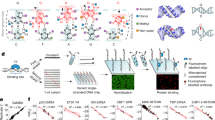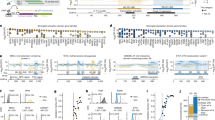Abstract
Although transcription activator–like effector nucleases (TALENs) can be designed to cleave chosen DNA sequences, TALENs have activity against related off-target sequences. To better understand TALEN specificity, we profiled 30 unique TALENs with different target sites, array length and domain sequences for their abilities to cleave any of 1012 potential off-target DNA sequences using in vitro selection and high-throughput sequencing. Computational analysis of the selection results predicted 76 off-target substrates in the human genome, 16 of which were accessible and modified by TALENs in human cells. The results suggest that (i) TALE repeats bind DNA relatively independently; (ii) longer TALENs are more tolerant of mismatches yet are more specific in a genomic context; and (iii) excessive DNA-binding energy can lead to reduced TALEN specificity in cells. Based on these findings, we engineered a TALEN variant that exhibits equal on-target cleavage activity but tenfold lower average off-target activity in human cells.
This is a preview of subscription content, access via your institution
Access options
Subscribe to this journal
Receive 12 print issues and online access
$259.00 per year
only $21.58 per issue
Buy this article
- Purchase on Springer Link
- Instant access to full article PDF
Prices may be subject to local taxes which are calculated during checkout





Similar content being viewed by others
Accession codes
References
Moscou, M.J. & Bogdanove, A.J. A simple cipher governs DNA recognition by TAL effectors. Science 326, 1501 (2009).
Boch, J. et al. Breaking the code of DNA binding specificity of TAL-type III effectors. Science 326, 1509–1512 (2009).
Doyon, Y. et al. Enhancing zinc-finger-nuclease activity with improved obligate heterodimeric architectures. Nat. Methods 8, 74–79 (2011).
Cade, L. et al. Highly efficient generation of heritable zebrafish gene mutations using homo- and heterodimeric TALENs. Nucleic Acids Res. 40, 8001–8010 (2012).
Miller, J.C. et al. A TALE nuclease architecture for efficient genome editing. Nat. Biotechnol. 29, 143–148 (2011).
Bedell, V.M. et al. In vivo genome editing using a high-efficiency TALEN system. Nature 491, 114–118 (2012).
Hockemeyer, D. et al. Genetic engineering of human pluripotent cells using TALE nucleases. Nat. Biotechnol. 29, 731–734 (2011).
Cermak, T. et al. Efficient design and assembly of custom TALEN and other TAL effector-based constructs for DNA targeting. Nucleic Acids Res. 39, e82 (2011).
Tesson, L. et al. Knockout rats generated by embryo microinjection of TALENs. Nat. Biotechnol. 29, 695–696 (2011).
Moore, F.E. et al. Improved somatic mutagenesis in zebrafish using transcription activator-like effector nucleases (TALENs). PLoS One 7, e37877 (2012).
Wood, A.J. et al. Targeted genome editing across species using ZFNs and TALENs. Science 333, 307 (2011).
Reyon, D. et al. FLASH assembly of TALENs for high-throughput genome editing. Nat. Biotechnol. 30, 460–465 (2012).
Mussolino, C. et al. A novel TALE nuclease scaffold enables high genome editing activity in combination with low toxicity. Nucleic Acids Res. 39, 9283–9293 (2011).
Li, T. et al. Modularly assembled designer TAL effector nucleases for targeted gene knockout and gene replacement in eukaryotes. Nucleic Acids Res. 39, 6315–6325 (2011).
Ding, Q. et al. A TALEN genome-editing system for generating human stem cell-based disease models. Cell Stem Cell 12, 238–251 (2013).
Lei, Y. et al. Efficient targeted gene disruption in Xenopus embryos using engineered transcription activator-like effector nucleases (TALENs). Proc. Natl. Acad. Sci. USA 109, 17484–17489 (2012).
Kim, Y. et al. A library of TAL effector nucleases spanning the human genome. Nat. Biotechnol. 31, 251–258 (2013).
Dahlem, T.J. et al. Simple methods for generating and detecting locus-specific mutations induced with TALENs in the zebrafish genome. PLoS Genet. 8, e1002861 (2012).
Gabriel, R. et al. An unbiased genome-wide analysis of zinc-finger nuclease specificity. Nat. Biotechnol. 29, 816–823 (2011).
Osborn, M.J. et al. TALEN-based gene correction for epidermolysis bullosa. Mol. Ther. 21, 1151–1159 (2013).
Mali, P. et al. CAS9 transcriptional activators for target specificity screening and paired nickases for cooperative genome engineering. Nat. Biotechnol. 31, 833–838 (2013).
Pattanayak, V., Ramirez, C.L., Joung, J.K. & Liu, D.R. Revealing off-target cleavage specificities of zinc-finger nucleases by in vitro selection. Nat. Methods 8, 765–770 (2011).
Maeder, M.L. et al. Rapid “open-source” engineering of customized zinc-finger nucleases for highly efficient gene modification. Mol. Cell 31, 294–301 (2008).
Pattanayak, V. et al. High-throughput profiling of off-target DNA cleavage reveals RNA-programmed Cas9 nuclease specificity. Nat. Biotechnol. 31, 839–843 (2013).
Miller, J.C. et al. An improved zinc-finger nuclease architecture for highly specific genome editing. Nat. Biotechnol. 25, 778–785 (2007).
Meckler, J.F. et al. Quantitative analysis of TALE-DNA interactions suggests polarity effects. Nucleic Acids Res. 41, 4118–4128 (2013).
Christian, M.L. et al. Targeting G with TAL effectors: a comparison of activities of TALENs constructed with NN and NK repeat variable di-residues. PLoS One 7, e45383 (2012).
Cong, L., Zhou, R., Kuo, Y.C., Cunniff, M. & Zhang, F. Comprehensive interrogation of natural TALE DNA-binding modules and transcriptional repressor domains. Nat. Commun. 3, 968 (2012).
Sander, J.D. et al. In silico abstraction of zinc finger nuclease cleavage profiles reveals an expanded landscape of off-target sites. Nucleic Acids Res. 41, e181 (2013).
Kim, Y., Kweon, J. & Kim, J.S. TALENs and ZFNs are associated with different mutation signatures. Nat. Methods 10, 185 (2013).
Grau, J., Boch, J. & Posch, S. TALENoffer: genome-wide TALEN off-target prediction. Bioinformatics 29, 2931–2932 (2013).
McNaughton, B.R., Cronican, J.J., Thompson, D.B. & Liu, D.R. Mammalian cell penetration, siRNA transfection, and DNA transfection by supercharged proteins. Proc. Natl. Acad. Sci. USA 106, 6111–6116 (2009).
Streubel, J., Blucher, C., Landgraf, A. & Boch, J. TAL effector RVD specificities and efficiencies. Nat. Biotechnol. 30, 593–595 (2012).
Sun, N., Liang, J., Abil, Z. & Zhao, H. Optimized TAL effector nucleases (TALENs) for use in treatment of sickle cell disease. Mol. Biosyst. 8, 1255–1263 (2012).
Benjamini, Y. & Hochberg, Y. Controlling the false discovery rate—a practical and powerful approach to multiple testing. J. Royal Stat. Soc. B 57, 289–300 (1995).
Noble, W.S. How does multiple testing correction work? Nat. Biotechnol. 27, 1135–1137 (2009).
Acknowledgements
J.P.G., V.P. and D.R.L. were supported by Defense Advanced Research Projects Agency HR0011-11-2-0003 and N66001-12-C-4207, US National Institutes of Health (NIH) NIGMS R01 GM095501 (D.R.L.), and the Howard Hughes Medical Institute (HHMI). D.R.L. was supported as a HHMI Investigator. V.P. was supported by award T32GM007753 from US National Institute of General Medical Sciences. D.R., S.Q.T., J.D.S. and J.K.J. were supported by a NIH Director Pioneer Award (DP1 GM105378). J.K.J. was supported by the Jim and Ann Orr Massachusetts General Hospital Research Scholar Award. We thank M.L. Maeder for preforming transfections and isolating genomic DNA, and C. Khayter and M. Goodwin for technical assistance.
Author information
Authors and Affiliations
Contributions
J.P.G., V.P., D.R., J.D.S. and S.Q.T. performed the experiments, designed the research, analyzed the data and wrote the manuscript. J.K.J. and D.R.L. designed the research, analyzed the data and wrote the manuscript.
Corresponding author
Ethics declarations
Competing interests
D.R.L. and J.K.J. have filed a provisional patent (US 61/868,846) related to this work and are consultants for Editas Medicine, a company that applies genome engineering technologies. J.K.J. has financial interests in Editas Medicine and Transposagen Biopharmaceuticals. J.K.J.'s interests were reviewed and are managed by Massachusetts General Hospital and Partners HealthCare in accordance with their conflict of interest policies.
Supplementary information
Supplementary Text and Figures
Supplementary Figures 1–16, Supplementary Tables 1–12, Supplementary Results, Supplementary Discussion and Supplementary Notes (PDF 19196 kb)
Supplementary Software
Source code. (ZIP 48 kb)
Rights and permissions
About this article
Cite this article
Guilinger, J., Pattanayak, V., Reyon, D. et al. Broad specificity profiling of TALENs results in engineered nucleases with improved DNA-cleavage specificity. Nat Methods 11, 429–435 (2014). https://doi.org/10.1038/nmeth.2845
Received:
Accepted:
Published:
Issue Date:
DOI: https://doi.org/10.1038/nmeth.2845
This article is cited by
-
CRISPR and KRAS: a match yet to be made
Journal of Biomedical Science (2021)
-
Applications of genome editing technology in the targeted therapy of human diseases: mechanisms, advances and prospects
Signal Transduction and Targeted Therapy (2020)
-
Enhancing gene editing specificity by attenuating DNA cleavage kinetics
Nature Biotechnology (2019)
-
High-resolution specificity profiling and off-target prediction for site-specific DNA recombinases
Nature Communications (2019)



